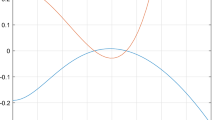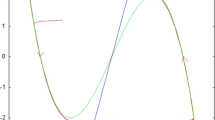Abstract
We revisit the description of reaction–diffusion phenomena within nonequilibrium thermodynamics and investigate the role of a nonstandard splitting of the entropy balance into the entropy production and the divergence of entropy flux. As previously reported by Pavelka et al. (Int J Eng Sci 78:192-217, 2014), a new term is identified following from the kinetic energy of diffusion. This newly appearing term acts as a thermodynamic force driving the reaction kinetics. Using the standard constitutive relations within the linear nonequilibrium thermodynamics, the governing equations for a reaction–diffusion problem in a two-species system are derived. They turn out to be linked to Burgers’ equation. It is shown that the onset of stability is not altered, but a non-periodic pattern can emerge. The latter follows from the relation of the governing equation to Burger’s equation with a source term. Hence, transients formed by glued and merging parabolic profiles are expected to appear at least in certain parameter regimes. We explore the significance of this effect and observe that for a comparable magnitude of the diffusion and of the new term stemming from the kinetic energy of diffusion, the solution is expected to be linked to the saw-tooth like solution to Burger’s equation rather than to the eigenmodes of the Laplacian. We conclude that the reaction–diffusion model proposed by Turing is robust to the addition of this effect of the kinetic energy of diffusion, at least when this new term is sufficiently small. As the governing equations can be rewritten into the classical reaction–diffusion problem but with reaction kinetics outside of the classical law of mass action, the analysis presented in this study suggests that a yet richer behaviour of the classical reaction–diffusion problems can be expected, if nonstandard reaction kinetics are considered.






Similar content being viewed by others
Data availability
All the computations and figures were generated using Wolfram Mathematica 12.1. The Mathematica notebook can be found at http://kmlinux.fjfi.cvut.cz/~klikavac/files/RD_n_KED.nb and shall be replaced by a permanent link to university repository if accepted.
Notes
Affinity of a reaction is a measure of its distance to equilibrium which corresponds to zero affinity. If affinity is positive (minding the sign in its definition and noting that \(\nu _{k\alpha }\) is negative for products and positive for reactants), the reaction runs spontaneously.
Again note the sign convention mentioned above, yielding higher extended affinity with higher kinetic energy of the reactants.
In particular, the thermodynamic flux \(J_i\) is not only proportional to the corresponding force \(X_i\), but also is linear in all the identified thermodynamic forces \(X_1,\ldots \), a situation which is referred to as coupling (of forces).
References
Auchmuty JFG, Nicolis G (1975) Bifurcation analysis of nonlinear reaction-diffusion equations-i. Evolution equations and the steady state solutions. Bull Math Biol 37(4):323–365
Bowen Ray M (1976) Theory of mixtures. In: Eringen AC (ed) Continuum Physics, vol 3. Academic Press, New York
Burgers Johannes Martinus (2013) The nonlinear diffusion equation: asymptotic solutions and statistical problems. Springer Science & Business Media, Berlin
De Groot Sybren Ruurds, Mazur Peter (2013) Non-equilibrium thermodynamics. Courier Corporation
Hess P (1987) Spatial homogeneity of stable solutions of some periodic-parabolic problems with neumann boundary conditions. J Diff Eqns 68(3):320–331
Klika V (2010) Comparison of the effects of possible mechanical stimuli on the rate of biochemical reactions. J Phys Chem B 114(32):10567–10572
Klika V (2014) A guide through available mixture theories for applications. Crit Rev Solid State Mater Sci 39(2):154–174
Klika V, Grmela M (2013) Coupling between chemical kinetics and mechanics that is both nonlinear and compatible with thermodynamics. Phys Rev E 87(1):012141
Klika V, Kozák M, Gaffney EA (2018) Domain size driven instability: self-organization in systems with advection. SIAM J Appl Math 78(5):2298–2322
Klika V, Krause AL (2018) Beyond onsager-casimir relations: shared dependence of phenomenological coefficients on state variables. J Phys Chem Lett 9(24):7021–7025
Klika V, Kubant J, Pavelka M, Benziger JB (2017) Non-equilibrium thermodynamic model of water sorption in nafion membranes. J Membrane Sci 540:35–49
Klika V, Maršík F (2009) Coupling effect between mechanical loading and chemical reactions. J Phys Chem B 113(44):14689–14697
Klika V, Pavelka M, Benziger JB (2017) Functional constraints on phenomenological coefficients. Phys Rev E 95(2):022125
Krause Andrew L, Gaffney Eamonn A, Maini Philip K, Klika Václav (2021) Modern perspectives on near-equilibrium analysis of turing systems. Philosophical Transactions of the Royal Society A (submitted)
Krishna R, Wesselingh JA (1997) The Maxwell-Stefan approach to mass transfer. Chem Eng Sci 52(6):861–911
Lebon G, Jou D, Casas-Vázquez J (2008) Understanding non-equilibrium thermodynamics, vol 295. Springer, Berlin
Madzvamuse A, Ndakwo HS, Barreira R (2015) Cross-diffusion-driven instability for reaction-diffusion systems: analysis and simulations. J Math Biol 70(4):709–743
Murray JD (2007) Mathematical biology: I. An introduction, vol 17. Springer Science & Business Media, Berlin
Nicolis G, Prigogine I (1981) Symmetry breaking and pattern selection in far-from-equilibrium systems. Proc Natl Acad Sci 78(2):659–663
Pavelka Michal, Klika Václav, Grmela Miroslav (2018) Multiscale thermo-dynamics: introduction to GENERIC. Walter de Gruyter GmbH & Co KG
Pavelka M, Maršík F, Klika V (2014) Consistent theory of mixtures on different levels of description. Int J Eng Sci 78:192–217
Prigogine I (1973) Irreversibility as a symmetry-breaking process. Nature 246(5428):67–71
Prigogine I, Lefever R (1968) Symmetry breaking instabilities in dissipative systems. ii. J Chem Phys 48(4):1695–1700
Prigogine I, Nicolis G (1967) On symmetry-breaking instabilities in dissipative systems. J Chem Phys 46(9):3542–3550
Prigogine I, Nicolis G (1971) Biological order, structure and instabilities. Quart Rev Biophys 4:107–148
Schnakenberg J (1979) Simple chemical reaction systems with limit cycle behaviour. J Theor Biol 81(3):389–400
Turing A (1952) The chemical basis of morphogenesis. Phil Trans Roy Soc B 237:37–72
Vanag VK, Epstein IR (2009) Cross-diffusion and pattern formation in reaction-diffusion systems. Phys Chem Chem Phys 11(6):897–912
Acknowledgements
V.K. would like to acknowledge the helpful discussions with Andrew Krause in particular those concerning numerics. V.K. is grateful for the support from the Czech Grant Agency, project number 20-22092S and European Regional Development Fund-Project ‘Center for Advanced Applied Science’ (no. CZ.02.1.01/0.0/0.0/16_019/0000778).
Author information
Authors and Affiliations
Corresponding author
Additional information
Communicated by Michael Hinczewski.
Appendix A: Details of the numerical solution
Appendix A: Details of the numerical solution
We include particular details for the discussion of the seemingly stationary profile to the governing equation (16). The final profile shown in Fig. 1 satisfies well the governing equation everywhere with the exception of boundary points, see Fig. 6. As this error does not scale with mesh size, we conclude that it is not an admissible smooth solution to the problem at hand.
Rights and permissions
About this article
Cite this article
Klika, V. Pattern formation revisited within nonequilibrium thermodynamics: Burgers’-type equation. Biol Cybern 116, 81–91 (2022). https://doi.org/10.1007/s00422-021-00908-3
Received:
Accepted:
Published:
Issue Date:
DOI: https://doi.org/10.1007/s00422-021-00908-3




